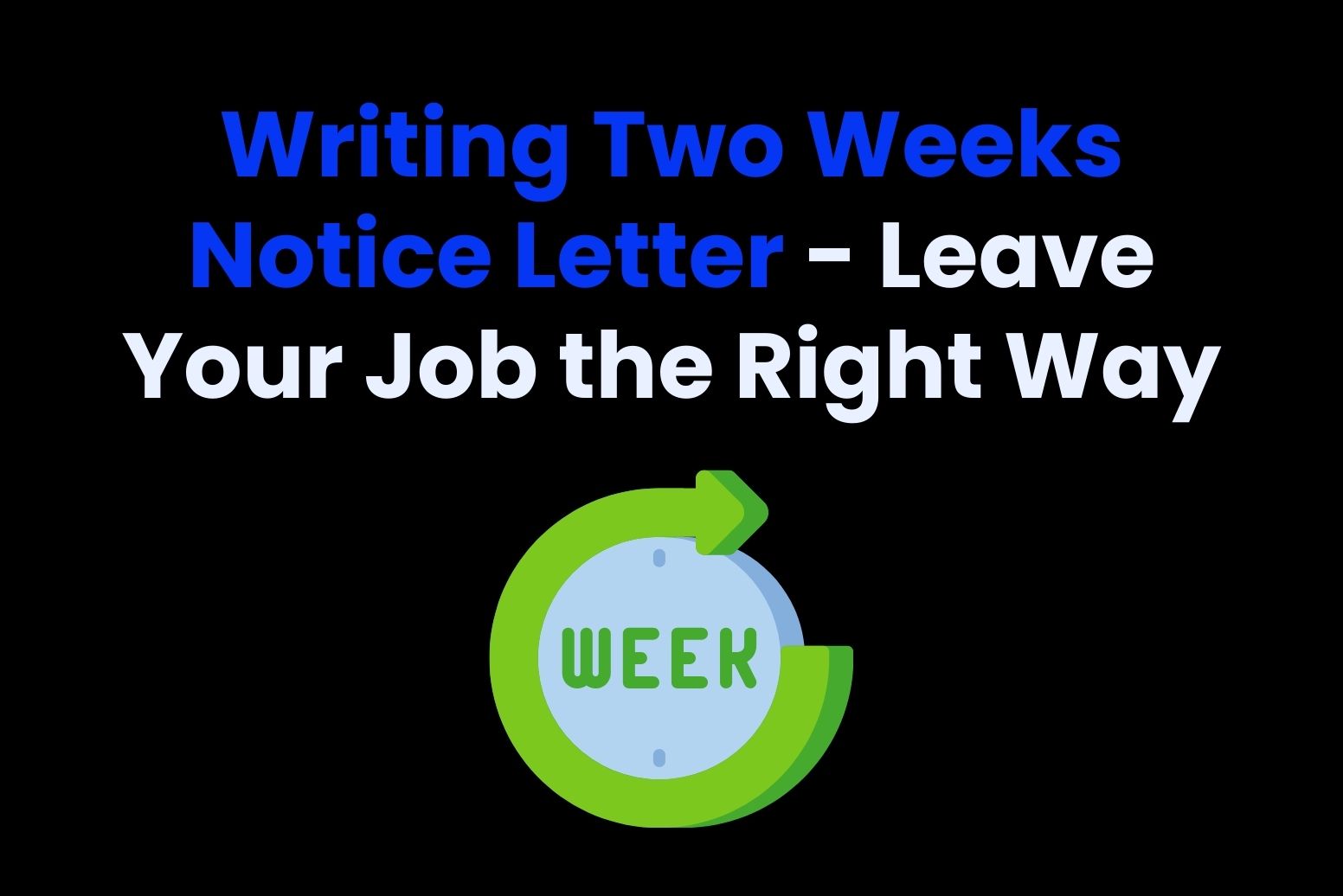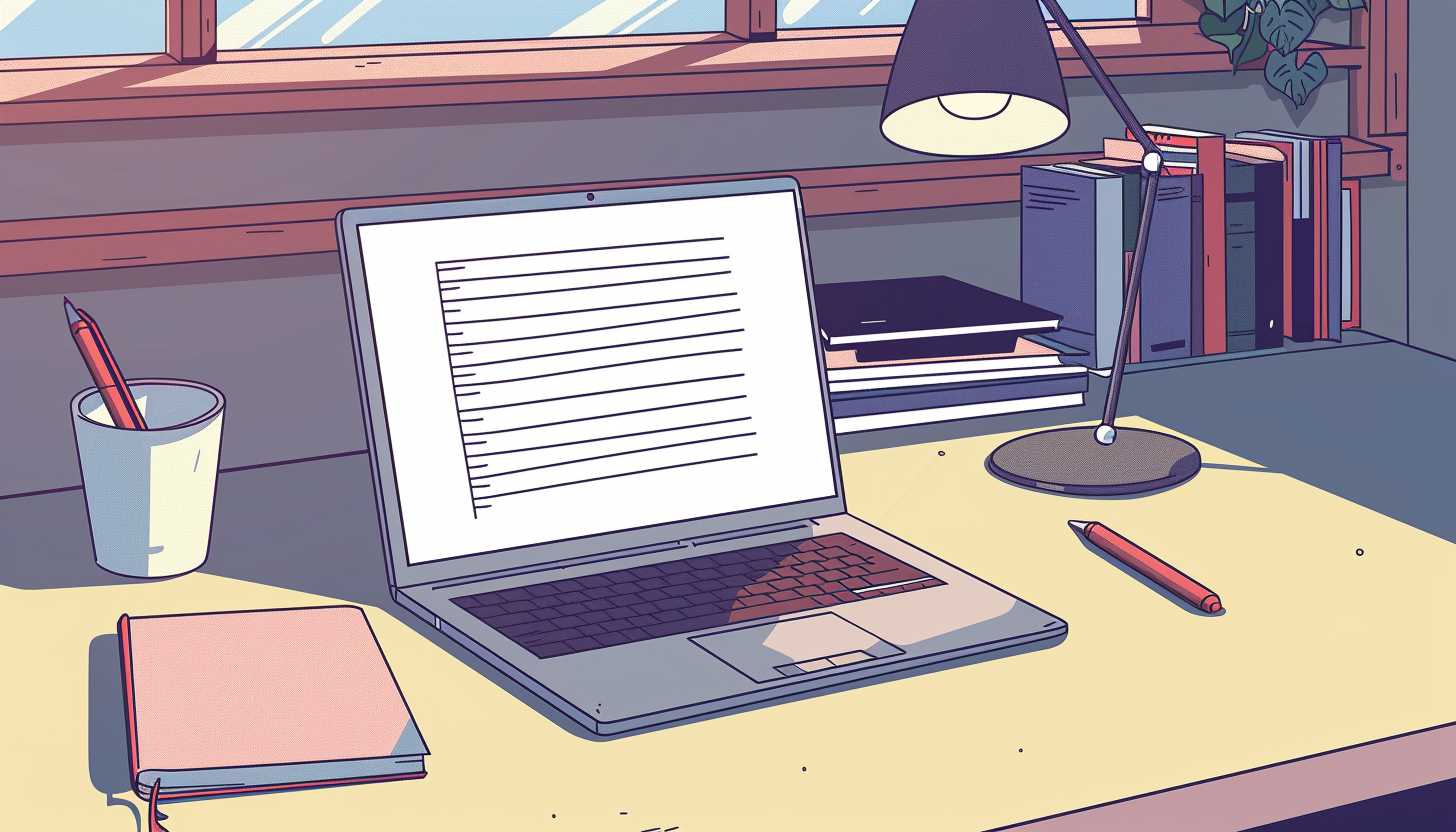Submitting a two weeks notice letter will probably be your first step toward leaving your current job. But what should you include in this letter, and why do you need to write it?
Giving notice when you leave a job is standard practice, and the terms of your notice period should be in your contract.
The good news is that a letter of notice is straightforward. It doesn’t need to be complicated, and you should keep it short and concise.
So, join us as we reveal the main sections and key details to include in your two weeks notice letter to your boss.

Before writing your two weeks notice letter: How much notice do you need to give?
If you have signed a contract of employment at your workplace, the required notice period will be stipulated in the terms. Research shows that the average notice period for most employees is between one and three months.
So, when is it acceptable to provide just two weeks of notice before resigning?
Well, this depends on where you live and how long you have been working in your job. For example, in the United Kingdom, if you have worked in your job for more than one month, you must give a notice period of at least one week if there’s nothing in your contract stipulating the notice period.
Giving two weeks’ notice is a good move if you have been in your job for one month or more and are not contractually required to provide more notice than this.
So, while it’s not necessarily required by law, providing two weeks’ notice is good practice. It’s also courteous and polite and provides your current employer enough time to find a replacement.
Preparing your two weeks notice letter: Step-by-step
If you’ve decided that writing a two weeks notice letter is the ideal way to resign from your job, we recommend following these steps to prepare your letter of resignation:
Step 1: Check your contract
The first and most crucial step is to check your contract carefully. Most employment contracts stipulate the required notice period that you must provide before leaving. This could be anything from one week to one year, depending on your role.
If you work in a casual job or follow a zero-hour contract where the terms aren’t clear, a two-week notice period should be more than sufficient. Still, it’s best to check any contract that you previously signed to ensure you’re aware of any contractual obligations.
Step 2: Speak to a friend or family member
Though the decision to resign from a job is ultimately yours, we recommend speaking to a close friend or family member before writing your letter.
Explain why you’re resigning and ask them for their advice. It’s best not to consult a colleague at this stage, as you don’t want your decision to become common knowledge at work just yet.
If you’re sure about resigning after your decision, it’s time to speak to your boss.
Step 3: Arrange a meeting with your line manager
We advise you to deliver the news of your resignation to your boss face to face. You can do this by arranging a meeting with them before, during, or after the workday.
This is a common courtesy and is a good way to approach a delicate subject. It’s best not to resign via email, over the phone, or by text message.
Although it’s a difficult conversation to have, announcing your decision to leave is best done in person. As soon as you’ve announced your decision to leave, you can put things in writing.
Working on your two weeks notice letter: Key sections to include
Congratulations – you’ve done the hard bit. Informing your manager of your decision to leave your job is daunting, so well done for taking the first steps.
After having the face-to-face conversation, you can put your resignation in writing. In other words, it’s time to write your two weeks notice letter.
The good news is that this letter is extremely easy to write, provided that you follow the basics. With that in mind, here are the key sections you need to include in your two weeks notice letter:
The subject line and formal greeting
The opening of your two weeks notice letter should include a suitable subject line. This is true whether you write an email or a letter. Example subject lines can include:
- REF: [Name] Resignation from [Company]
- RE: My Resignation & Two Weeks Notice Letter
- FAO [Recipient]: [Name’s] Notice of Resignation
As for the greeting, we recommend something formal. Begin the letter with “Dear” rather than “Hello” or “Hi.” After all, this is a formal document and the company will keep the letter on file for future reference.
Statement of resignation
Once you have greeted the recipient and given a clear subject line, it’s time to announce your resignation. Your statement of resignation should be in the first paragraph, as it makes no sense to leave it until later in the letter.
A two weeks notice letter should be succinct, so you don’t need to worry about breaking the ice or bridging the subject. Get straight to the point in your resignation letter by beginning with your statement. Here are a few ideas to consider:
Resignation statement example one
I’m writing to inform you of my resignation from [Company], effective immediately. As agreed, I will work a two-week notice period beginning today. Therefore, my last day of work will be [date].
Resignation statement example two
Please accept this letter as confirmation of my resignation from [Company]. My two-week notice period begins today [date], meaning my last day of work will be on [date].
Resignation statement example three
I am writing this letter to confirm my resignation from [Company]. I will work a two-week notice period, beginning on [date] and ending on [date].
Expression of gratitude
Whether or not you’re happy about leaving, it’s polite to express your gratitude in a two weeks notice letter. You don’t need to go over the top with praise or thanks, but it’s a good idea to show some form of gratitude to your employer.
This paragraph should follow your statement of resignation, which is a good way to soften the tone of the letter. Here are a few examples of how you can express your gratitude:
Expression of gratitude example one
I’d like to thank you for all the guidance and support you’ve given me in my [number of years] at [company]. Working with you has been a pleasure, and I wish you the very best in the future.
Expression of gratitude example two
Working for [company] has been one of the best experiences of my career. I’ve learned so much as part of the team, and I’m grateful for the numerous development opportunities that have been provided to me.
Expression of gratitude example three
I’m extremely grateful for the faith you have shown in me during my time at [company]. It has been a pleasure to work alongside you and I wish you and the rest of the team the very best for the future.
Offer of support (optional) and closing
The final section of the letter is the closing. If appropriate, and should you want to, you can offer to support your employer as they look for your replacement.
This is only necessary for specific roles, and two weeks may not be enough time for your manager to find a replacement. Alternatively, you can mention that you’re happy to see out a specific project or complete certain tasks before leaving.
While it helps to be specific with your offer of support, below are some generic statements to consider:
Offer of support example one
If I can do anything to help you find my replacement, please let me know.
Offer of support example two
Should you need me to complete any specific tasks before I leave, please let me know. I am also very happy to support you in the process of recruiting my replacement if that would be helpful.
Offer of support example three
In my final two weeks at [company], please let me know if I can help with the transition as you look for a new employee. If I can be of any assistance, I’d be very happy to help.
As for closing your two weeks notice letter, choose a formal ending. Something like “Yours sincerely” or “Kind regards” works well and is appropriate for a letter to your boss.
You can also read our recent article to learn more about ending a letter appropriately for more tips on bringing your two weeks notice letter to a close.
Bringing it all together: A two weeks notice letter template

As we’ve shown, keeping your resignation letter short, succinct, and to the point will make your life much easier. It will also save you from providing unnecessary information to your boss regarding your decision to leave.
After all, you don’t need to give a reason for resigning, and you will notice that we’ve not included one in our examples above. If you want to tell your boss why you’re leaving, that’s up to you. You may even want to mention this in a face-to-face conversation rather than in your resignation letter.
So, now we’ve covered the basics, below is a sample two weeks notice letter template that you can customize before sending it to your boss. Please note that we’ve fictionalized the names and company details in our example:
Two weeks notice letter example
[Your Address]
[Date]
Reference: David Webster’s Resignation Letter & Notice.
Dear Stewart,
I’m writing this letter to confirm my resignation from my position as a Sales Advisor at M-Tech Business Supplies & Solutions. I will work a two week notice period, meaning my last day in the office will be December 16th, 2024.
Please accept my sincere gratitude for everything you have done for me during my three years at M-Tech. I have learned a lot from you, and I am extremely grateful for the opportunities you have given me to grow and develop in my role.
Should you require any support in looking for my replacement or would like me to help with anything else related to my role before leaving, please let me know.
Yours sincerely,
[Signature]
David Webster.
[Email & phone number]
General tips for writing your two weeks notice letter
As we bring this guide to a close, we want to leave you with some general tips that will help you write your letter. We understand that letter writing can be challenging, which is why we want to make it a stress-free process.
So, here are some things to bear in mind as you prepare and write your two weeks notice letter to your boss:
Maintain a formal tone
If you’ve worked for your employer for a long time and have a good relationship with your boss, it might be tempting to write in an informal tone. However, this isn’t a good idea, even if you regularly write informal emails to one another.
Your two weeks notice letter will be added to your employment file so it should be formal and well written. You don’t want to leave a poorly written letter as one of your final acts at a company you’ve worked at for a while.
Check your grammar and spelling
There’s nothing worse than spending a long time on a letter only to notice spelling mistakes when you’ve printed it off.
Given the speed at which most of us type, typos are inevitable. Therefore, before printing and signing your letter, use our AI Grammar Checker.
It picks up on spelling mistakes, grammatical errors, and typos. It also offers simple ways to improve the flow and tone of your letter.
Our AI Grammar Tool is extremely easy to use, and it takes just a few minutes to run your letter through it before printing. It’s a useful step to ensure your letter is as professional as it can be.
Keep the letter brief
One mistake that many people make when writing their two weeks notice letter is providing too much information.
Whether you’re moving away, starting a new job, or retiring, you don’t need to tell your boss why you’re leaving in writing. Of course, you might decide to tell them during a conversation, but this information doesn’t need to be in the letter.
In terms of word count, aim for between 200 and 300 words for your two weeks notice letter. This is more than long enough to cover the key points we’ve introduced in this article.
Send a hard copy
Though you’re probably more familiar with email correspondence at work, it’s best to send a hard copy of your resignation letter.
To do this, print it off and sign it manually. Then, slip the letter into an envelope and address it to your boss. You can either send it in the mail or hand it to your boss in person at the office.
Just remember to inform your boss in advance, as you don’t want to blindside them with a resignation letter out of nowhere.
Plan your next steps
Are you leaving for a new job? Or are you taking some time away to assess your options? Whatever your reason for resigning and handing in your notice, you need to plan your next steps.
Our AI Tools can help you put together a strategy, be it to apply for a job or even plan a trip around the world on your sabbatical. After handing in your notice, you need to be prepared for what comes next!
Prepare your two weeks notice letter with confidence today
If you’re about to resign, writing a clear and concise two weeks notice letter takes much of the stress away. It’s the best way to inform your manager of your decision and ensures that your employment file reflects your decision to leave.
You can use our examples and template above to craft the perfect two weeks notice letter. Also, don’t forget to check out our AI Email Writer to help you with its composition.
Two weeks notice letter FAQ
How do I write my two weeks notice letter?
Break your notice letter down into the following sections: subject line & greeting, statement of resignation, expression of gratitude, offer of help and closing. You can use our examples above to help structure the ideal letter to your boss.
Do you give a two weeks notice letter to a manager or HR department?
If your company has an HR department, you can give the letter to a member of the team if you like. Alternatively, you can hand it directly to your manager. Ultimately, it’s up to you, but most people hand their resignation letters directly to their line managers.
Is a two weeks notice letter necessary?
Though it might not be stipulated in your contract or by employment law, you should provide a notice letter out of courtesy. This gives your employer a bit of time to find a replacement and ensures a smooth transition when you leave.






